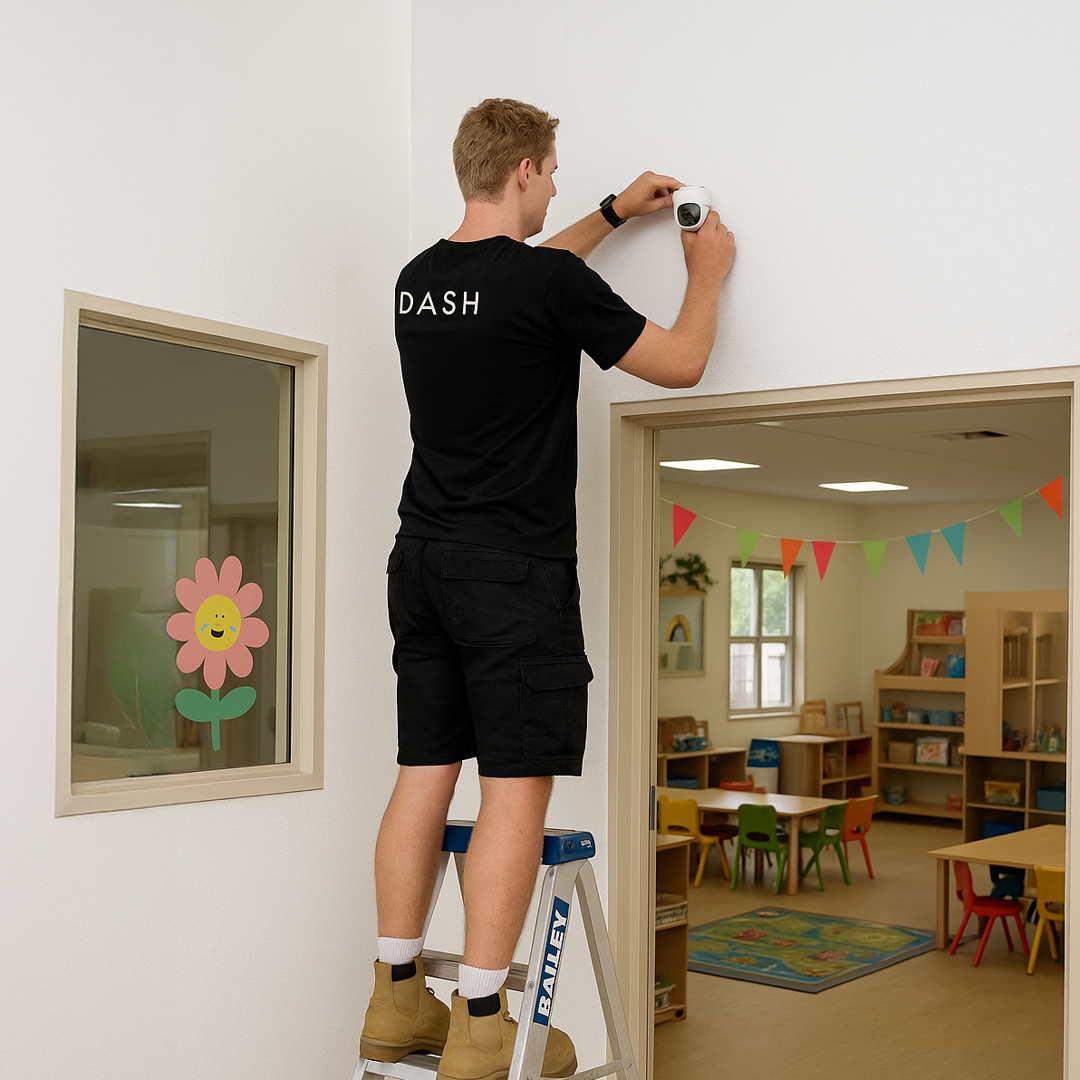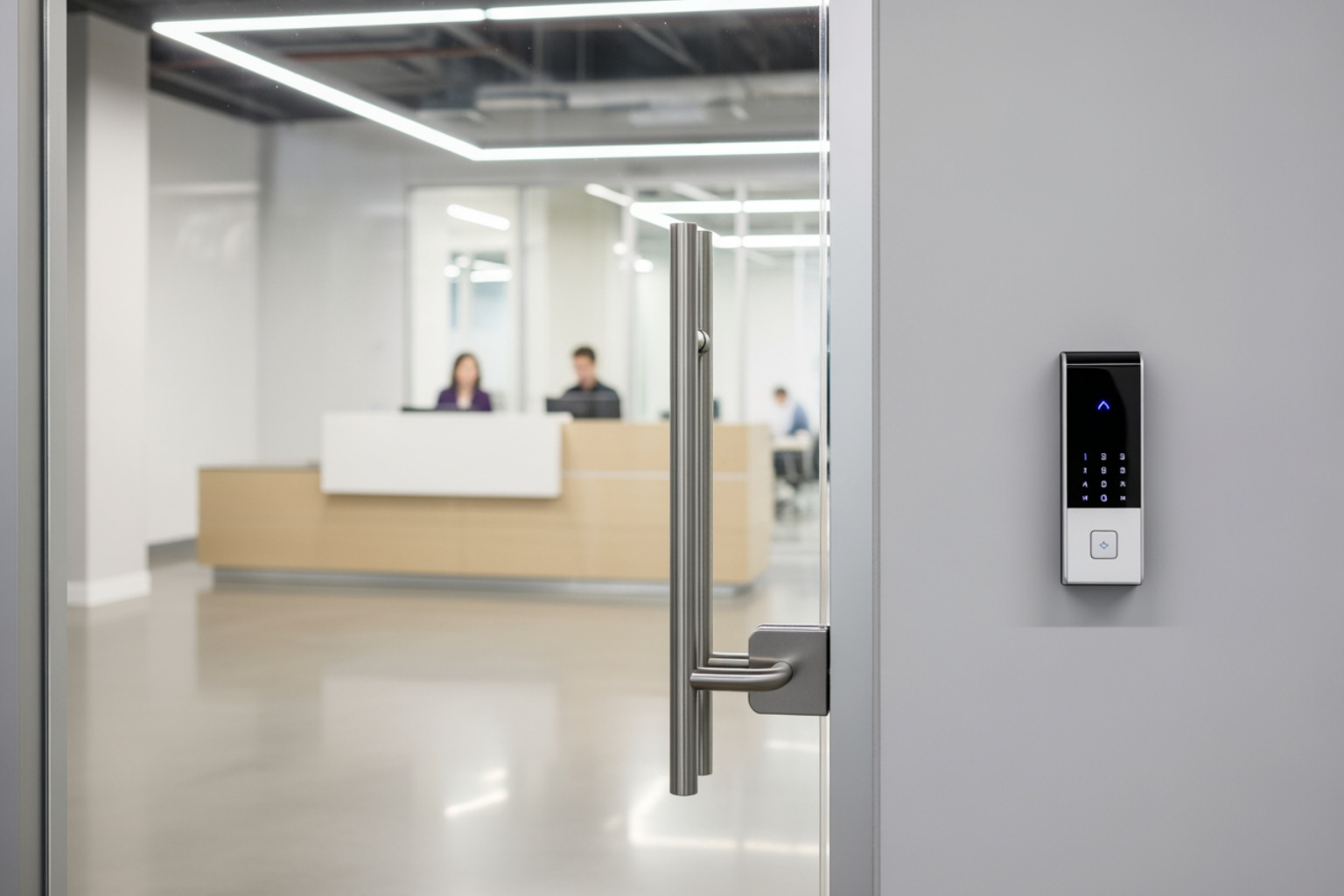If you manage a school or childcare centre, you’re likely asking: “Will our CCTV meet the September 2025 National Quality Framework (NQF) reforms?” The rules have tightened, and the stakes are high: child safety, parental trust, and legal compliance.
We get it. You need a straightforward path. Since 2008, DASH Symons Group has helped directors and committees across the Gold Coast and Brisbane upgrade and manage CCTV the right way. We install, service, and support compliant systems, and keep them that way.
The new NQF expectations raise the bar on privacy, transparency, and secure handling of footage. In practice, that means:
- Formal CCTV Policy: Document purpose, locations, who can access footage, and how data is handled.
- Clear Communication: Visible signage at all entry points, plus notices to families and staff.
- Secure Data Management: Encrypted storage, strict access controls, and retention for at least 31 days.
- Prohibited Zones: No cameras in bathrooms, change rooms, showers, or other private areas—no exceptions.
- Technical Standards: Systems should align with Australian Standards AS 4806 and AS/NZS 62676 for image quality, performance, and installation.
Many legacy systems (and off-the-shelf kits) don’t meet these requirements. Common issues include poor camera placement, missing signage, weak passwords, and no written policy.
A Practical Guide to CCTV Compliance in Schools and Childcare
1) The Problem: Why Generic Solutions Fail
One-size-fits-all camera kits rarely fit the realities of childcare and school environments. Every site has different traffic patterns, privacy risks, lighting, and policies. Copy-and-paste designs lead to gaps, blurry footage at entrances, cameras pointed off-site, or blind spots in high-risk areas.
Older systems struggle with image quality and retention, and many weren’t installed to Australian Standards. Integration is another trap: mixing brands without planning can break features. While standards like ONVIF and RTSP help devices “talk,” some brands still have limitations. Without expert design and testing, you may not get reliable motion events, analytics, or stable streams.
2) Your Legal Obligations in Plain English
- Privacy Act 1988 (Federal): CCTV captures personal information. You must collect it fairly, store it securely, and share it lawfully.
- NQF Reforms (September 2025): Expect stronger emphasis on privacy, transparency, and digital technology policies. Document the purpose for CCTV, get proper consents, and define who can access footage and when.
- Australian Standards (AS 4806 & AS/NZS 62676): These standards guide professional installation, performance, and configuration. In short: cameras must be placed and set up to capture clear, usable images.
- Consent & Transparency: Put families and staff at ease with upfront communication and signage. For helpful guidance, see Victoria’s policy: CCTV in Schools – Installation and Management: Policy | education.vic.gov.au.
If your system is more than a few years old, it’s worth auditing it now. Our compliance consulting services translate legal requirements into practical steps that fit your site.
3) Security vs Privacy: Getting the Balance Right
CCTV helps deter misconduct, support investigations, and reassure families. But surveillance should never feel intrusive. Children and staff have a right to privacy, so cameras must avoid private spaces and be used for safety and not micromanagement.
Explain CCTV use clearly in staff onboarding and parent communications. Be specific about purposes (e.g., safety and incident review), and avoid features (like live streaming to parents) that undermine trust or create privacy risks.

4) Best-Practice Camera Placement
- Where to Place: Entrances, reception, corridors, playgrounds, storage rooms, and car parks. Aim for clear faces at entry points and wide coverage in shared spaces.
- Where Not to Place: Toilets, change rooms, showers, private offices, or anywhere a reasonable expectation of privacy exists.
- What to Avoid: Aiming cameras into neighbouring properties or public areas outside your boundaries, unless lawful and necessary.
Smart placement is about outcomes, not total coverage. A few well-positioned cameras that meet standards beat a lot of cameras that don’t.
5) Signage and Communication
- Entry Signage: Prominent signs at all entrances stating that CCTV is in use, who to contact, and the purpose.
- Audio Recording: If audio is enabled, state this clearly on signage and in your policy.
- Written Notice: Provide families and staff with a plain-English summary of what’s recorded, why, how long it’s stored, and who can access it.

- Retention: Keep footage for at least 31 days, then securely delete unless needed for an investigation or legal reason.
- Storage Options: On-premise NVRs (network video recorders) or reputable cloud video services. Either way, use encryption at rest and in transit.
- Access Control: Limit access to authorised roles only. Log every access—who viewed what, when, and why. Review logs regularly.
- Device Management: Cloud management should be limited to your security devices (cameras/NVRs), not broader IT systems.
- Procedures: Have a clear process for handling footage requests from families, staff, or police. Always check privacy rules before sharing.
Regular security camera maintenance ensures recordings are available when you need them most. A camera with a dirty lens or a full hard drive is effectively non-compliant.
7) Integration: How Systems Work Together
In schools and childcare, CCTV often needs to work alongside access control, intercoms, alarms, and gates. Integration is a tailored process, not a magic “single platform.”
- Common Methods: ONVIF for camera discovery/control and RTSP for video streaming between compatible devices and software.
- Practical Outcomes: Link a door alarm to trigger a camera bookmark, or show a front gate camera on the intercom monitor. Some brands support deeper features; others are limited.
- Why It Matters: The right integrations make incident response faster and daily operations smoother without overcomplicating your setup.
Our integrated security solutions focus on reliable, supported connections rather than fragile “workarounds.”
8) What Good Looks Like
- Childcare Example: A centre installs compliant entry cameras and signage, sets retention to 31 days, and restricts access to the director and assistant director. When a playground fall is reported, staff quickly find the clip and share it appropriately, reassuring parents and supporting incident reporting.
- School Example: A primary school links front office intercoms with CCTV and a sliding gate. When visitors buzz in, reception sees them clearly and records the event. After-hours, unauthorised gate access triggers an alarm and marks the exact camera timeline for review.
Results are practical: fewer disputes, faster investigations, and better peace of mind for families and staff. When systems are designed to standards, and supported over time they simply work.
9) The DASH Difference
We’re a family-run, Australian-owned business based on the Gold Coast since 2008. We help schools and childcare centres in the Gold Coast and Brisbane regions with end-to-end support:
- Expert Audit: We assess your policies, signage, camera placement, and storage against NQF reforms, the Privacy Act, and Australian Standards.
- Tailored Design & Installation: We specify cameras, storage, and network infrastructure to suit your site. We also install access control, intercoms, alarms, gate automation, and electrical works so everything connects cleanly.
- Documentation & Training: Clear user guides, staff training, and privacy documentation that pass scrutiny.
- Ongoing Care: Our Dash Care Plan (DCP) delivers scheduled maintenance, firmware updates, health checks, and rapid repairs to keep you compliant.
If you prefer a simple next step, start with a compliance consulting session. We’ll map out exactly what needs to change and what can stay.
Partnering for Compliance and Peace of Mind
Achieving CCTV compliance under the NQF isn’t a one-off project—it’s an ongoing commitment to privacy, safety, and clear communication. You don’t need to steer it alone.
Since 2008, DASH has installed, serviced, and supported security technologies for education providers across the Gold Coast and Brisbane. We bring 16+ years of hands-on experience and a down-to-earth approach that saves time and reduces risk for directors and committees.
Your CCTV Compliance Checklist
Use this checklist as a working roadmap and review it annually or after any major change:
- Privacy Impact Assessment (PIA): Identify risks before installing or upgrading.
- Written CCTV Policy: State purposes, camera locations, lawful bases, access roles, and data handling.
- Consent & Transparency: Provide clear notices to families and staff; record consent where required.
- Signage: Install compliant, visible signage at all entries; include audio recording notice if applicable.
- Placement to Standards: Align with AS 4806 and AS/NZS 62676; avoid private areas and off-site views.
- Storage & Retention: Encrypt footage; retain a minimum of 31 days; define a “legal hold” process for incidents.
- Role-Based Access: Limit viewing to authorised staff; log who accessed what, when, and why.
- Access Requests: Document a process for responding to individuals or police, consistent with privacy law.
- Integration Testing: If linking to access control, intercoms, alarms, or gates, verify ONVIF/RTSP compatibility and any brand-specific limits.
- Network & Electrical: Ensure reliable power, protected data cabling, and secure network segmentation for cameras and NVRs.
- Maintenance Schedule: Clean lenses, check recording health, verify time sync, and test backups.
- Staff Training: Cover privacy obligations, footage handling, and incident response.
- Policy Reviews: Update annually and whenever laws or systems change; record review dates.
Our CCTV systems and programmed maintenance (DCP) are designed to keep you compliant day-to-day, not just at installation.
How an Expert Partner Keeps You Compliant
Our process is simple and proven:
1) Expert Audit: We benchmark your setup against the NQF reforms, Privacy Act 1988, and AS 4806/AS/NZS 62676. You’ll get a clear gap report and priorities.
2) Custom Design & Installation: We specify and install cameras, NVRs/cloud video, access control, intercoms, alarms, gate automation, data cabling, and electrical works. Integration is tailored using supported methods (e.g., ONVIF, RTSP) and tested end-to-end.
3) Ongoing Support: With the Dash Care Plan (DCP), we handle maintenance, updates, and repairs—so footage is there when you need it and your policy stays current.
As a local, family-run team, we’re here when you need us. We build long-term partnerships with schools and childcare centres across the Gold Coast and Brisbane.
Let’s Talk! Start with a Compliance Audit
If you want clarity, start with an audit. We’ll review your current system, policy, signage, and storage, then outline a practical plan to meet NQF 2025 requirements.
Ready to make compliance simple? Contact us for a CCTV compliance audit, or explore our consulting services and CCTV systems. We install, service, and support systems that protect children, reassure families, and give you peace of mind year after year.




